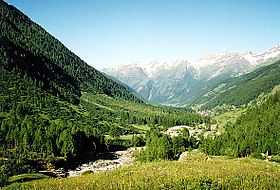Lötschental



The Lötschental is the largest valley on the northern side of the Rhône valley in the canton of Valais in Switzerland. It lies in the Bernese Alps, with the Lonza river running down the length of the valley from its source within the Langgletscher.
Geography
The picturesque valley extends about 27 kilometers (17 mi) from the Lötschenlücke (3178 m) at the top of the Langgletscher to the mouth of the valley at Steg/Gampel (630 m). It is surrounded by 3,000 meter high mountains, including the Bietschhorn (3,934 m), the Hockenhorn (3,293 m), the Wilerhorn (3,307 m) and the Petersgrat (3,205 m). The Jungfrau-Aletsch Protected Area is the most glaciated area in the Swiss Alps, and was declared a Natural World Heritage Site by decision of UNESCO on December 13, 2001, along with southern and eastern parts of the Lötschental.
The main villages of the Lötschental are Wiler and Kippel, with 538 and 383 inhabitants respectively. Other villages in the valley include Ferden and Blatten. Altogether, the valley has approximately 1500 inhabitants.
History
The Lötschental was likely first settled during the Roman period, but remained largely cut off from the outside world until the beginning of the twentieth century. The valley remained remote and difficult to access, especially during the winters, until the construction of the Lötschbergbahn, between 1907 and 1913, connected it to an international railway line.
Traditional farming, involving primarily agriculture and cattle-breeding, began to disappear with the extension of the highway to Blatten after World War II. Tourism thus increasingly came to function as the valley’s primary industry, especially since the construction of a gondola lift from Wiler to Lauchernalp in 1972. The Lötschental is now a popular destination for hiking and winter sports. In November 2003, the new gondola lift of the Hockenhorngrat was opened, and Lauchernalp and Fischbiel now contain 1500 beds for rent, five restaurants and one hotel. The lift system supports a varied ski terrain with a vertical drop of 1000m or more in a good winter and 33 km of ski runs.
Tschäggättä

External links
- Jungfrau-Aletsch-Bietschhorn-Gebiet
- Lötschental Tourism
- Gemeinde Kippel
- Laucheralp Webcam
- Lötschental in German, French and Italian in the online Historical Dictionary of Switzerland.
- Tschäggättä
- Tschäggättä a Swiss Carnival in the Lötschental Valley
Coordinates: 46°25′N 7°50′E / 46.417°N 7.833°E